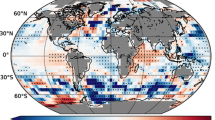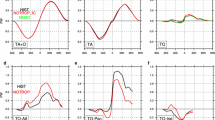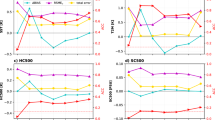Abstract
We investigated the influence of dynamical in-consistency of initial conditions on the predictive skill of decadal climate predictions. The investigation builds on the fully coupled global model “Coupled GCM for Earth Simulator” (CFES). In two separate experiments, the ocean component of the coupled model is full-field initialized with two different initial fields from either the same coupled model CFES or the GECCO2 Ocean Synthesis while the atmosphere is initialized from CFES in both cases. Differences between both experiments show that higher SST forecast skill is obtained when initializing with coupled data assimilation initial conditions (CIH) instead of those from GECCO2 (GIH), with the most significant difference in skill obtained over the tropical Pacific at lead year one. High predictive skill of SST over the tropical Pacific seen in CIH reflects the good reproduction of El Niño events at lead year one. In contrast, GIH produces additional erroneous El Niño events. The tropical Pacific skill differences between both runs can be rationalized in terms of the zonal momentum balance between the wind stress and pressure gradient force, which characterizes the upper equatorial Pacific. In GIH, the differences between the oceanic and atmospheric state at initial time leads to imbalance between the zonal wind stress and pressure gradient force over the equatorial Pacific, which leads to the additional pseudo El Niño events and explains reduced predictive skill. The balance can be reestablished if anomaly initialization strategy is applied with GECCO2 initial conditions and improved predictive skill in the tropical Pacific is observed at lead year one. However, initializing the coupled model with self-consistent initial conditions leads to the highest skill of climate prediction in the tropical Pacific by preserving the momentum balance between zonal wind stress and pressure gradient force along the equatorial Pacific.












Similar content being viewed by others
References
Balmaseda M, Anderson D (2009) Impact of initialization strategies and observations on seasonal forecast skill. Geophys Res Lett 36:L01701. doi:10.1029/2008GL035561
Barnett TP, Graham NE, Cane MA, Zebiak SE, Dolan SC, O’Brien J, Legler DM (1988) On the prediction of the El Niño of 1986–1987. Science 241:192–196
Bell MJ, Martin MJ, Nichols NK (2004) Assimilation of data into an ocean model with systematic errors near the equator. Q J R Meteorol Soc 130:873–893. doi:10.1256/qj.02.109
Bellucci A, Haarsma R et al (2014) An assessment of a multi-model ensemble of decadal climate predictions. Clim Dyn 44:2787–2806. doi:10.1007/s00382-014-2164-y
Booth BBB, Dunstone NJ, Halloran PR, Andrews T, Bellouin N (2012) Aerosols implicated as a prime driver of twentieth-century North Atlantic climate variability. Nature 484:228–232
Branstator G, Teng H (2010) Two limits of initial-value decadal predictability in a CGCM. J Clim 23:6292–6311
Branstator G, Teng H (2012) Potential impact of initialization on decadal predictions as assessed for CPMI5 models. Geophys Res Lett 39:L12703. doi:10.1029/2012GL051794
Branstator G, Teng H, Meehl G, Kimoto M, Knight J, Latif M, Rosati A (2012) Systematic estimates of initial value decadal predictability for six AOGCMs. J Clim 25:1827–1846
Bryden HL, Brady EC (1985) Diagnostic model of the three-dimensional circulation in the upper equatorial Pacific Ocean. J Phys Oceanogr 15:1255–1273
Chang P, Zhang L, Saravanan R, Vimont DJ, Chiang JCH, Ji L, Seidel H, Tippett MK (2007) Pacific meridional mode and El Niño-Southern oscillation. Geophys Res Lett 34:L16608. doi:10.1029/2007GL030302
Collins M (2002) Climate predictability on interannual to decadal time scales: the initial value problem. Clim Dyn 19:671–692
Doblas-Reyes FJ, Balmaseda M, Weisheimer A, Palmer T (2011) Decadal climate prediction with the European Centre for Medium-Range Weather Forecasts coupled forecast system: impact of ocean observations. J Geophys Res 116:D19111. doi:10.1029/2010JD015395
Doblas-Reyes FJ, Andreu-Burillo I, Chikamoto Y, García-Serrano J, Guemas V, Kimoto M, Mochizuki T, Rodrigues LRL, van Oldenborgh GJ (2013) Initialized near-term regional climate change prediction. Nat Commun. doi:10.1038/ncomms2704
Dunstone NJ, Smith DM, Booth BBB, Hermanson L, Eade R (2013) Anthropogenic aerosol forcing of Atlantic tropical storms. Nat Geosci 6:534–539
Fu L-L, Cazeneve A (2000) Satellite altimetry and earth sciences: a handbook of techniques and applications. International Geophysics Series 69, Academic Press, San Diego
Goddard L, Kumar A, Solomon A, Smith D, Boer G et al (2013) A verification framework for interannual-to-decadal predictions experiments. Clim Dyn 40:245–272
Guémas V, Doblas-Reyes FJ, Andreu-Burillo I, Asif M (2013) Retrospective prediction on the global warming slowdown in the past decade. Nat Clim Change 3:649–653. doi:10.1038/nclimate1863
Hawkins E, Sutton R (2009) The potential to narrow uncertainty in regional climate predictions. Bull Am Meteorol Soc 90:1095–1107
Hazeleger W, Guemas V, Wouters B, Corti S, Andreu-Burillo I, Doblas-Reyes F, Wyser K, Caian M (2013) Multiyear climate prediction using two initialization strategies. Geophys Res Lett 40:1794–1798. doi:10.1002/grl.50355
ICPO (International CLIVAR Project Office) (2011) Data and bias correction for decadal climate predictions. CLIVAR publication series no. 150. http://eprints.soton.ac.uk/171975/1/ICPO150_Bias.pdf
Jin F (1997) An equatorial ocean recharge paradigm for ENSO. Part I: methodology. J Atmos Sci 54:811–829
Jolliffe IT, Stephenson DB (2003) Forecast verification: a practitioner’s guide in atmospheric science. Wiley, Chichester
Karspeck A, Yeager S, Danabasoglu G, Teng H (2014) An evaluation of experimental decadal predictions using CCSM4. Clim Dyn 44:907–923. doi:10.1007/s00382-014-2212-7
Kharin V, Boer G, Merryfield W, Scinocca J, Lee WS (2012) Statistical adjustment of decadal predictions in a changing climate. Geophys Res Lett 39:L19705. doi:10.1029/2012GL052647
Köhl A (2014) Evaluation of the GECCO2 ocean synthesis: transports of volume, heat and freshwater in the Atlantic. Q J R Meteorol Soc 141:166–181. doi:10.1002/qj.2347
Komori N, Takahashi K, Komine K, Motoi T, Zhang X, Sagawa G (2005) Description of sea-ice component of coupled ocean-sea-ice model fort he earth simulator (OIFES). J Earth Simul 4:31–45
Kug JS, An SI, Jin FF, Kang IS (2005) Predictions for El Niño and La Niña onsets and their relation to the Indian Ocean. Geophys Res Lett 32:L05706. doi:10.1029/2004GL021674
Laloyaux P, Balmaseda MA, Dee D, Mogensen K, Janssen P (2015) A coupled data assimilation system for climate reanalysis. Q J R Meterol Soc. doi:10.1002/qj.2629
Magnusson L, Alonso-Balmaseda M, Corti S, Moltenie F, Stockdale T (2012) Evaluation of forecast strategies for seasonal and decadal forecasts in presence of systematic model errors. Clim Dyn 41:2393–2409. doi:10.1007/s00382-012-1599-2
Masuda S, Awaji T, Sugiura N, Toyoda T, Ishikawa Y, Horiuchi K (2006) Interannual variability of temperature inversions in the subarctic North Pacific. Geophys Res Lett 33:L24610. doi:10.1029/2006GL027865
Matei D, Pohlmann H, Jungclaus J, Müller W, Haak H, Marotzke J (2012) Two tales of initializing decadal climate prediction experiments with the ECHAM5/MPI-OM model. J Clim 25:8502–8523
Meehl GA, Teng H (2012a) Case studies for initialized decadal hindcasts and predictions in the Pacific regions. Geophys Res Lett 39:L22705. doi:10.1029/2012GL053423
Meehl GA, Teng H (2012b) CMIP5 multi-model initialized hindcasts for the mid-1970s shift and early 2000s hiatus and predictions for 2016–2035. Geophys Res Lett. doi:10.1002/2014gl059256
Meehl GA, Goddard L et al (2009) Decadal prediction: can it be skillful? Bull Am Meteorol Soc 90:1467–1485
Meehl GA, Goddard L et al (2014) Decadal climate prediction: an update from the trenches. Bull Am Meteorol Soc 95:243–267. doi:10.1175/BAMS-D-12-00241.1
Mochizuki T, Ishii M, Kimoto M et al (2010) Pacific decadal oscillation hindcasts relevant to near-term climate prediction. Proc Natl Acad Sci 107:1833–1837
Mochizuki T, Chikamoto Y, Kimoto M, Ishii M, Tatebe H, Komuro Y, Sakamoto T, Watanabe M, Mori M (2012) Decadal prediction using a recent series of MIROC global climate models. J Meteorol Soc Jpn 90A:373–383
Mulholland D, Laloyaux P, Haines K, Balmaseda MA (2015) Origin and impact of initialisation shocks in coupled atmosphere-ocean forecasts. Mon Weather Rev. doi:10.1175/MWR-D-15-0076.1
Müller WA, Pohlmann H, Sienz F, Smith D (2014) Decadal climate predictions for the period 1901–2010 with a coupled climate model. Geophys Res Lett 41:2100–2107. doi:10.1002/2014GL059259
Murphy JM, Booth BBB, Collins M, Harris GR, Sexton DMH, Webb MJ (2007) A methodology for probabilistic predictions of regional climate change from perturbed physics ensembles. Philos Trans R Soc 365:1993–2028. doi:10.1098/rsta.2007.2077
Murphy J, Kattsov V, Keenlyside N, Kimoto M, Meehl G, Mehta V, Pohlmann H, Scaife A, Smith D (2010) Towards prediction of decadal climate variability and change. Proc Environ Sci 1:287–304. doi:10.1016/j.proenv.2010.09.018
Nakajima T, Tsukamoto M, Tsushima Y, Numaguti A, Kimura T (2000) Modeling of the radiative process in an atmospheric general circulation model. Appl Opt 39:4869–4878
Neelin JD, Latif M (1998) El Niño dynamics. Phys Today 51(12):32–36
Ohfuchi W, Nakamura H, Yoshioka MK, Enomoto T, Takaya K, Peng X, Yamane S, Nishimura T, Kurihara Y, Ninomiya K (2004) 10-km mesh meso-scale resolving simulations of the global atmosphere on the Earth Simulator: preliminary outcomes of AFES (AGCM for the Earth Simulator). J Earth Simul 1:8–34
Otterå OH, Bentsen M, Drange H, Suo L (2010) External forcing as a metronome for Atlantic multidecadal variability. Nat Geosci 3:688–694. doi:10.1038/NGEO955
Pierce D, Barnett T, Tokmakian R, Semtner A, Maltrud M, Lysne J, Craig A (2004) Initializing a coupled climate model from observed conditions. Clim Change 62:13–28
Pohlmann H, Jungclaus JH, Köhl A, Stammer D, Marotzke J (2009) Initializing decadal climate predictions with the GECCO oceanic synthesis: effects on the North Atlantic. J Clim 22:3926–3938
Pohlmann H, Müller WA, Kulkarni K, Kameswarrao M, Matei D, Vamborg FSE, Kadow C, Illing S, Marotzke J (2013) Improved forecast skill in the tropics in the new MiKlip decadal climate predictions. Geophys Res Lett 40:5798–5802. doi:10.1002/2013GL058051
Polkova I, Köhl A, Stammer D (2014) Impact of initialization procedures on the predictive skill of a coupled ocean–atmosphere model. Clim Dyn 42:3151–3169. doi:10.1007/s00382-013-1969-4
Rayner NA, Parker DE, Horton EB, Folland CK, Alexander LV, Rowell DP, Kent EC, Kaplan A (2003) Global analyses of sea surface temperature, sea ice, and night marine air temperature since the late nineteenth century. J Geophys Res 108:4407. doi:10.1029/2002JD002670
Smith DM, Cusack S, Colman AW et al (2007) Improved surface temperature prediction for the coming decade from a global climate model. Science 317:796–799. doi:10.1126/science.1139540
Smith DM, Scaife AA, Kirtman BP (2012) What is the current state of scientific knowledge with regard to seasonal and decadal forecasting? Environ Res Lett. doi:10.1088/1748-9326/7/1/015602
Smith DM, Eada R, Pohlmann H (2013) A comparison of full-field and anomaly initialization for seasonal to decadal climate prediction. Clim Dyn 41:3325–3338. doi:10.1007/s00382-013-1683-2
Stammer D, Balmaseda M, Heimbach P, Köhl A, Weaver A (2016) Ocean data assimilation in support of climate applications: status and perspectives. Annu Rev Mar Sci 8:491–518. doi:10.1146/annurev-marine-122414-034113
Sugiura N, Awaji T, Masuda S, Mochizuki T, Toyoda T, Miyama T, Igarashi H, Ishikawa Y (2008) Development of a four-dimensional variational coupled data assimilation system for enhanced analysis and prediction of seasonal to interannual climate variations. J Geophys Res 113:C10017. doi:10.1029/2008JC004741
Taylor KE, Stouffer RJ, Meehl GA (2012) An overview of CMIP5 and the experiment design. Bull Am Meteorol Soc 93:485–498
Tebaldi C, Knutti R (2007) The use of the multi-model ensemble in probabilistic climate projections. Philos Trans R Soc 365:2053–2075
Thoma M, Gerdes R, Greatbatch RJ, Ding H (2015) Partially coupled spin-up of the MPI-ESM: implementation and first results. Geosci Model Dev 8(1):51–68. doi:10.5194/gmd-8-51-2015
Troccoli A, Palmer T (2007) Ensemble decadal predictions from analysed initial conditions. Philos Trans R Soc 365:2179–2191
Vera C, Barange M, Dube OP, Goddard L, Griggs D, Kobysheva N, Odada E, Parey S, Polovina J, Poveda G, Seguin B, Trenberth K (2010) Needs assessment for climate information on decadal time scales and longer. Proc Environ Sci 1:275–286. doi:10.1016/j.proenv.2010.09.017
Villarini G, Vecchi GA (2013) Projected increases in North Atlantic tropical cyclone intensity from CMIP5 models. J Clim 26:3231–3240
von Storch H, Zwiers FW (1999) Statistical analysis in climate research. Cambridge University Press, Cambridge
Wang S-Y, L’Heureux M, Chia HH (2012) Enso prediction one year in advance using western North Pacific sea surface temperatures. Geophys Res Lett 39:L05702. doi:10.1029/2012GL050909
White WB, Tai C-K (1995) Inferring interannual changes in global upper ocean heat storage from TOPEX altimetry. J Geophys Res 100:24943–24954
Yang X et al (2013) A predictable AMO-like pattern in the GFDL fully coupled ensemble initialization and decadal forecasting system. J Clim 26:650–661
Acknowledgments
The authors wish to thank Prof. Toru Nozawa for his support in compiling the radiative forcing data. The numerical calculations were carried out on the server of the Deutsches Klimarechenzentrum (DKRZ). The presented research was funded in part through a European Union 7th Framework Programme (FP7 2007–2013) project provided to the Universität Hamburg under Grant Agreement No. 308299 NACLIM (www.naclim.eu).
Author information
Authors and Affiliations
Corresponding author
Additional information
This paper is a contribution to the special issue on Ocean estimation from an ensemble of global ocean reanalyses, consisting of papers from the Ocean Reanalyses Intercomparsion Project (ORAIP), coordinated by CLIVAR-GSOP and GODAE OceanView. The special issue also contains specific studies using single reanalysis systems.
Rights and permissions
About this article
Cite this article
Liu, X., Köhl, A., Stammer, D. et al. Impact of in-consistency between the climate model and its initial conditions on climate prediction. Clim Dyn 49, 1061–1075 (2017). https://doi.org/10.1007/s00382-016-3194-4
Received:
Accepted:
Published:
Issue Date:
DOI: https://doi.org/10.1007/s00382-016-3194-4




